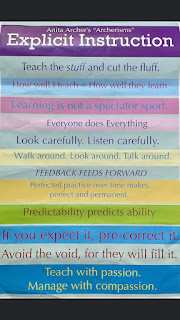…explicit instruction is helpful for all students, harmful for none, and crucial for some (Snowling & Hulme, 2005).
Mary Stowe, our SIM strategy instructor, had this quote in her email signature. I loved it the moment I first saw it and it lead me down a learning path that I was excited to share with you. It's been on my heart for a while.
I have questioned my own explicit talk when teaching. Sometimes, I think I use too many words and what I am saying is not clear. Brene' Brown would tell you that unclear is unkind. And that is so true. It is unkind to be teaching others something and have it be confusing. That leads to frustration and no learning. Definitely not the goal of this instructor.
But how does one get better at explicit teaching? We have heard it said. Good instruction is explicit and systematic. As a systems girl, I get that part. But how do I become more explicit?
In my own personal quest to learn more, here are some resources I have found. My heart is that you have found them as helpful as I have and will grow your skills as a teacher. #knowbetterdobetter
2) To start, watch this Explicit Instruction video from VLP (Virginia Literacy Partnerships, new PALS) (3:12 minutes). Then, view the Module from VLP on Explicit Instruction (28:56 minutes). This will go more in-depth. Here is an infographic from VLP as well that complements both resources.
3) Anita Archer is the queen of explicit instruction. Here is a blog post from The Measured Mom, describing Archer's elements from her book shown below. I absolutely LOVE her elements....like there are too many that would be my favorite.














